A rangefinding reticle is a type of reticle that allows a shooter to estimate the distance to a target. When used in a riflescope, a rangefinding reticle can significantly improve accuracy and reduce the likelihood of missed shots. This is particularly important for long range shooting, where even a slight miscalculation in the distance can cause a significant deviation in bullet impact.
In this guide, we will provide a step-by-step guide on how to use a riflescope that has a rangefinding reticle, including how to familiarize yourself with the reticle, calibrate the reticle, and use it to estimate range. Whether you are a beginner or an experienced shooter, this guide will help you get the most out of your riflescope and improve your accuracy in the field.
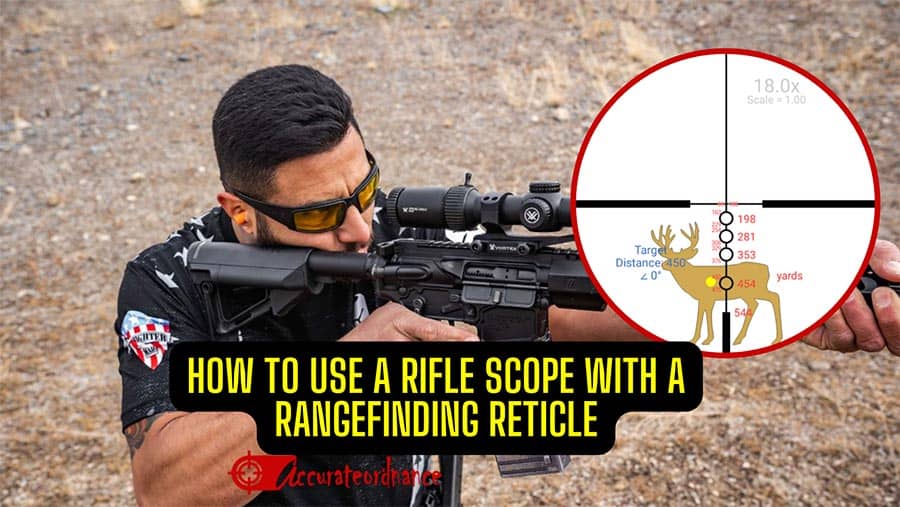
- Difference Between a Riflescope with a rangefinding reticle and a rangefinder
- Type of range finding reticle and features
- How to calibrate the rangefinding reticle to match your rifle’s ballistics.
- How to read and interpret the reticle markings to estimate range in MRAD
- How to read and interpret the reticle markings to estimate range in MOA
- Practice with your rangefinding reticle
Difference Between a Riflescope with a rangefinding reticle and a rangefinder
A riflescope with a rangefinding reticle is a type of scope that has a specialized reticle or crosshairs that can help estimate the distance to the target. The reticle has markings that correspond to the size of a target at a known distance, and by comparing the size of the target in the reticle to the actual size of the target, the shooter can estimate the distance. This type of scope can be useful in certain hunting and shooting situations where knowing the distance to the target is important for accuracy.
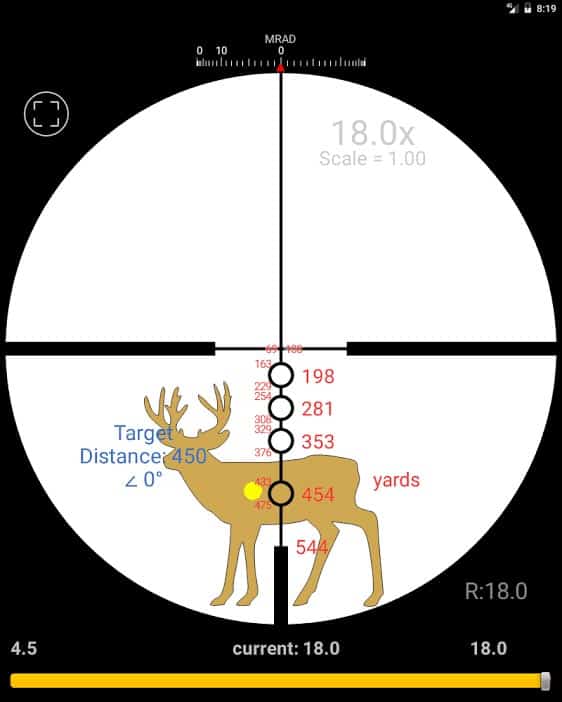
Image: gungoals.com
A rangefinder, on the other hand, is a separate device that uses a laser (laser rangefinder) or other technology to measure the distance to a target with greater precision. Rangefinders can be handheld, mounted on a tripod, or even integrated into a scope, and they can provide distance measurements to targets that are several hundred yards away.

While a riflescope with a range finding reticle and a rangefinder can help shooters estimate distance, a rangefinder typically provides more accurate measurements and is better suited for long range shooting. However, a riflescope with a rangefinding reticle can be a more affordable and convenient option for shooters who only need to estimate distances at shorter ranges. In summary, a range-finding reticle riflescope is not the same as a rangefinder.
Type of range finding reticle and features
There are several types of rangefinding reticles, each with its own unique features and benefits. The most common types of rangefinding reticles are:
BDC (Bullet Drop Compensating) Reticle
As mentioned earlier, this type of reticle features holdover marks that compensate for bullet drop at different ranges. The holdover marks are typically arranged in a stair-step pattern and are calibrated for a specific caliber and bullet weight. The shooter can use the holdover marks to aim directly at the target at different ranges, rather than having to adjust the scope’s elevation. BDC reticles are popular among hunters and shooters.
Mil-Dot Reticle
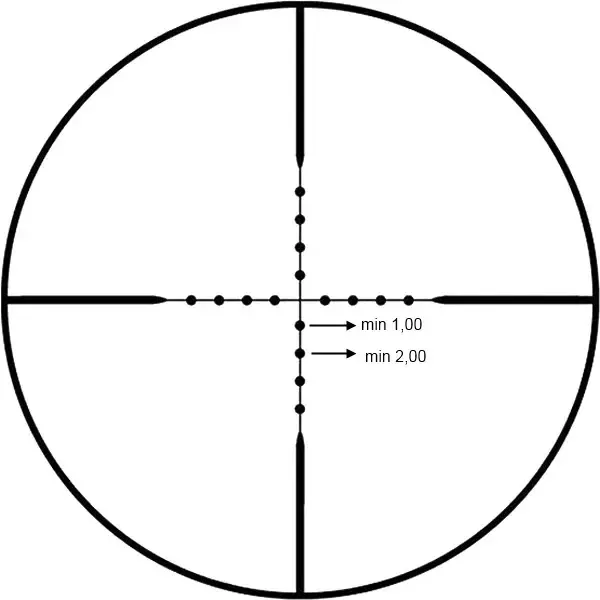
The mil-dot reticle is a popular choice for military snipers and long-range shooters. The reticle features dots or hash marks that are spaced at one milliradian (mil) intervals, which can be used to estimate range and compensate for bullet drop and wind drift. The mil-dot reticle is versatile and can be used with a variety of calibers and bullet weights.
MOA (Minute of Angle) Reticle
Like the mil-dot reticle, the MOA reticle features hash marks that are spaced at intervals of one MOA, which can be used to estimate range and adjust for bullet drop and wind drift. One advantage of the MOA reticle is that it is compatible with MOA turrets, which can simplify adjustments for windage and elevation.
Horus Reticle
The Horus reticle is a specialized reticle designed for long-range shooting and is often used by military snipers and precision shooters. The reticle features a series of dots and hash marks that are arranged in a grid pattern, which can be used to estimate range and compensate for bullet drop and wind drift. The Horus reticle is highly versatile and can be used with a wide range of calibers and bullet weights. It can also be used to estimate lead on moving targets.
One of the key features of the Horus reticle is its “Horus System,” which is a set of formulas and methods for using the reticle to make accurate long-range shots. The Horus System provides a comprehensive set of instructions for ranging, holding, and dialing with the reticle, which can help shooters to make precise shots in challenging conditions.
Christmas Tree Reticle
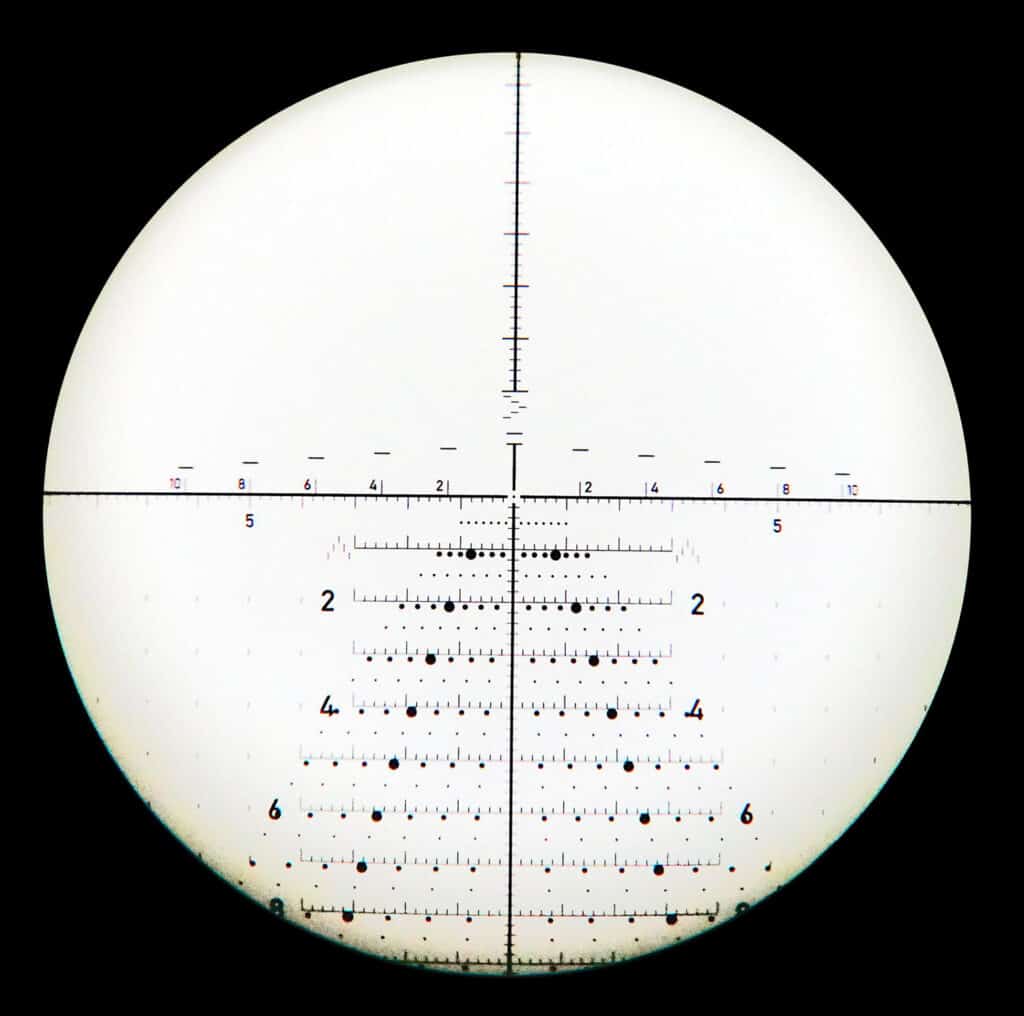
The Christmas Tree reticle is a specialized reticle designed for precision shooting and is often used in competition shooting. The reticle features a series of dots and hash marks that are arranged in a “Christmas tree” pattern, which can be used to estimate range, compensate for bullet drop and wind drift, and adjust for moving targets. One of the advantages of the Christmas Tree reticle is that it provides a lot of holdover options, which can be helpful in situations where the shooter needs to quickly acquire a target at a variety of ranges. The Christmas Tree reticle is also popular among long-range hunters who need to make precise shots at extended ranges.
How to calibrate the rangefinding reticle to match your rifle’s ballistics.
Calibrating the rangefinding reticle to match your rifle’s ballistics is an important step to ensure that your reticle is accurate for your specific rifle and ammunition. Here are the steps to calibrate your rangefinding reticle:
Determine your rifle’s ballistics
The first step is to determine your rifle’s ballistics, including the velocity of your ammunition and the trajectory of your bullet. This information can usually be found in the manufacturer’s specifications or on the ammunition box.
Choose a zero distance
The next step is to choose a zero distance for your rifle. This is the distance at which your rifle’s sights or scope are calibrated to be most accurate. For most rifles, the zero distance is 100 yards, but it can vary depending on the caliber and ammunition.
Adjust the reticle markings
Once you have determined your rifle’s ballistics and chosen a zero distance, you can adjust the reticle markings to match your rifle. This can be done using the turrets on your scope, which will allow you to adjust the position of the reticle in relation to the bullet trajectory.
Test and adjust
After making initial adjustments, it’s important to test the accuracy of your reticle by shooting at a known distance and comparing the point of impact to the reticle markings. If necessary, make additional adjustments to fine-tune the reticle.
How to read and interpret the reticle markings to estimate range in MRAD
Understand the MIl reticle markings
The first step is to understand the markings on your specific reticle. The spacing and arrangement of markings can vary depending on the type of reticle you are using. For example, a Mil-Dot reticle has dots spaced one mil apart, while a BDC reticle has markings that correspond to specific bullet trajectories. Some scopes have evenly marked hold overs, while others have uneven spacing. Understanding how the markings are spaced and what they represent is critical to using the reticle to estimate range.
Determine the size of the target
To estimate range using the reticle, you need to know the size of the target. Since you are going to be measuring in mil in the next step, you can estimate the target size either in centimeter (if you want to get the range in meters) or inches (if you want to range in yards).
Measure the target in Mil
Once you know the size of the target in relation to the reticle markings, you can use the markings to measure the target in the reticle. For example, if you are using a Mil-Dot reticle, you can count the number of mils that the target covers in the reticle. This will give you a measurement that can be used to estimate range.
Calculate the range
With the target size and the number of reticle markings it covers, you can use a formula or chart to calculate the range. The formula or chart will depend on the type of reticle you are using. For example, with a Mil-Dot reticle, you can use the following formula to estimate range:
Mil Dot Formula for Range Estimation:
For ranging in yards
Range (y) = Size (inches) ÷ Size (MILs) x 27.77
.
For ranging in meters
Range (m) = Size (cm) ÷ Size (MILs) x 10
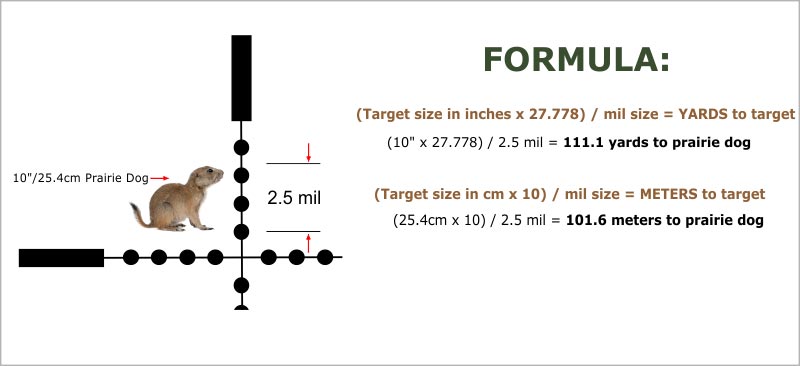
It’s important to note that estimating range using a reticle is not an exact science, and it can take practice and experience to get accurate results. It’s also important to keep in mind that other factors, such as wind, can affect bullet trajectory and accuracy, so it’s important to account for these factors as well when using a reticle to estimate range.
How to read and interpret the reticle markings to estimate range in MOA
The process for range finding with an MOA scope is almost the same as the MRAD. The only difference is in the formula.
Understand the MOA reticle marking
The MOA reticle, also known as the Minute of Angle reticle, is a type of crosshair pattern used in riflescopes to help shooters adjust for distance and windage. The markings on the MOA reticle are typically measured in minutes of angle, which is a unit of angular measurement used in ballistics.
The MOA reticle markings consist of small hash marks or dots that are spaced a certain distance apart. These markings are usually placed on both the horizontal and vertical axes of the reticle. The distance between each mark is equal to one minute of angle, which is approximately 1.047 inches at 100 yards. Therefore, the spacing of the marks will vary depending on the magnification of the scope and the distance to the target.
Determine the size of the target
To estimate the range in MOA using your reticle, you need to know the size of the target. The unit you want to use to calculate the final distance will determine the unit used to estimate the target size. So if you want to get the range in meters, then you have to estimate the targte size in centimeters. And if you want to range in yards, then the target size must be in inches.
Measure the target in MOA
After getting the size of the target, you have to use the markings to measure the target in the reticle. For example, if you are using a MOA reticle, you can count the number of MOA that the target covers in the reticle. This will give you a measurement that can be used to estimate range in MOA.
Calculate the range
Once the target size and the number of MOA markings it covers is determined, you can use a formula to calculate the range.
MOA Formula for Range Estimation:
MOA Range Estimation in Yards:
Range (y) = Size (inches) ÷ Size (MOA) x 95.5
MOA Range Estimation in Meters:
Range (m) = Size (cm) ÷ Size (MOA) x 34.38
Practice with your rangefinding reticle
Practicing with your rangefinding reticle is crucial for becoming proficient in estimating range and making accurate shots in the field. It’s important to remember that using a rangefinding reticle takes practice and experience to become comfortable with. Shooting at different distances and types of targets will help you understand how to best use the reticle markings to estimate range and adjust your aim.
Regular practice will also help you become more familiar with your rifle and scope, allowing you to make quick and accurate adjustments when needed. In addition, practicing with your rifle and scope will give you confidence in your equipment and your abilities, which can be a significant factor in successful hunting or shooting.

Mike Hardesty is a published freelance gun writer. He also possesses specialized expertise in rifle scopes With dozens of articles and reviews published in Pew Pew Tactical, Snipercountry.com, and TTAG (The Truth About Guns), Mike is considered a firearms expert. His special area of expertise is handguns.
Mike is a long-time shooter. He has been punching paper targets, taking deer and other game and shooting at competitions since about 1975. Other related pursuits include reloading and bullet casting. He currently reloads for over 10 calibers, both handgun and rifle. His reloads, particularly for 9mm, were in great demand during the height of the ammo shortage among family and friends. He donated hundreds of rounds to informal shooting sessions. He was quoted as saying “I do not sell my reloads but I sure will help my guys shoot ’em for free!”. He has a few cherished firearms that he has inherited or otherwise procured — those are his favorites.
He earned B.S. and M.S. degrees from Indiana State University in 1974-1975.
He’s a firearm experts and is the founder of mhardesty.com.
